Abstract
The purpose of this investigation was to identify newer antimicrobial agents that may be useful in the therapy of melioidosis. The in vitro susceptibilities of 199 clinical isolates of Pseudomonas pseudomallei to 22 antibiotics were determined by standard disk diffusion, and those to 13 antibiotics were determined by agar dilution. Over 90% of the isolates were susceptible to imipenem, piperacillin-tazobactam, piperacillin, ceftazidime, ticarcillin-clavulanate, ampicillin-sulbactam, and carumonam by both methods. Standard disk diffusion yielded unacceptably high false-susceptibility results with aztreonam, ciprofloxacin, and temafloxacin. Piperacillin, ceftazidime, imipenem, and ciprofloxacin were not bactericidal for three selected P. pseudomallei strains as determined by time-kill curve methods. Furthermore, addition of ciprofloxacin to piperacillin, ceftazidime, or imipenem did not enhance bactericidal activity. One hundred ninety-four strains showed weak beta-lactamase production that did not increase upon incubation with cefoxitin. These findings suggest that several newer antimicrobial agents may prove useful in the treatment of melioidosis. However, results of susceptibility studies involving P. pseudomallei and newer agents must be interpreted with caution.
Full text
PDF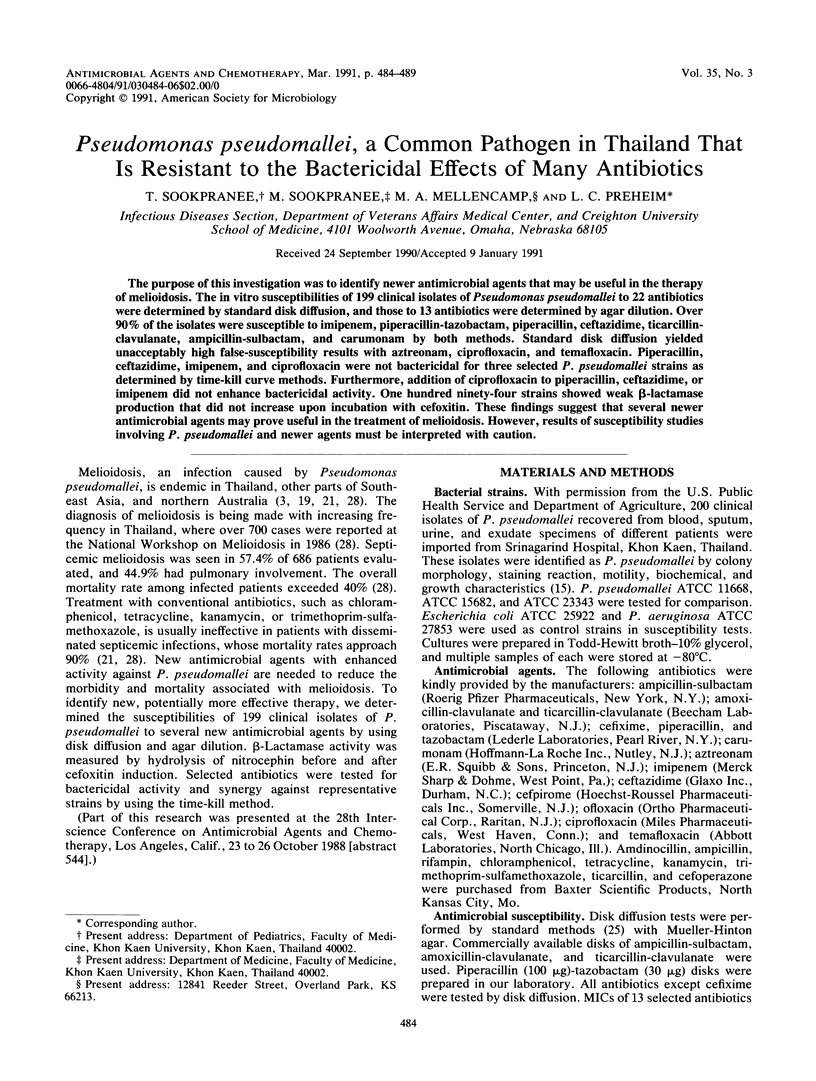
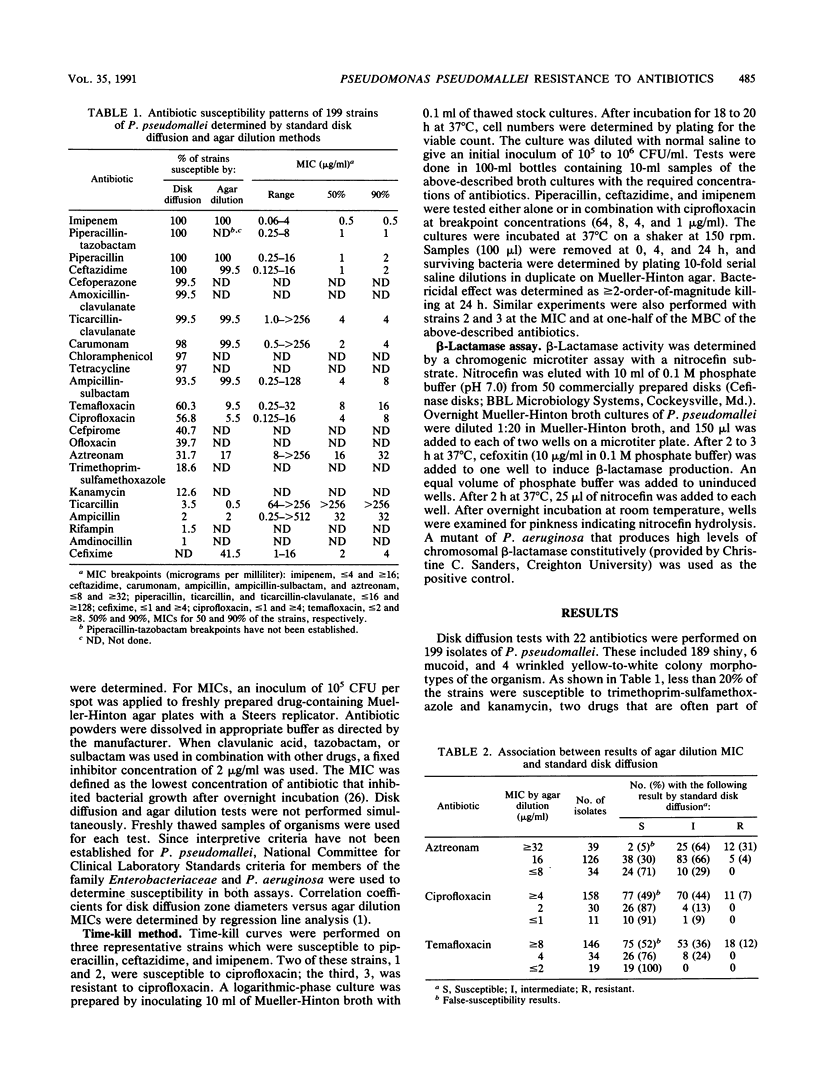
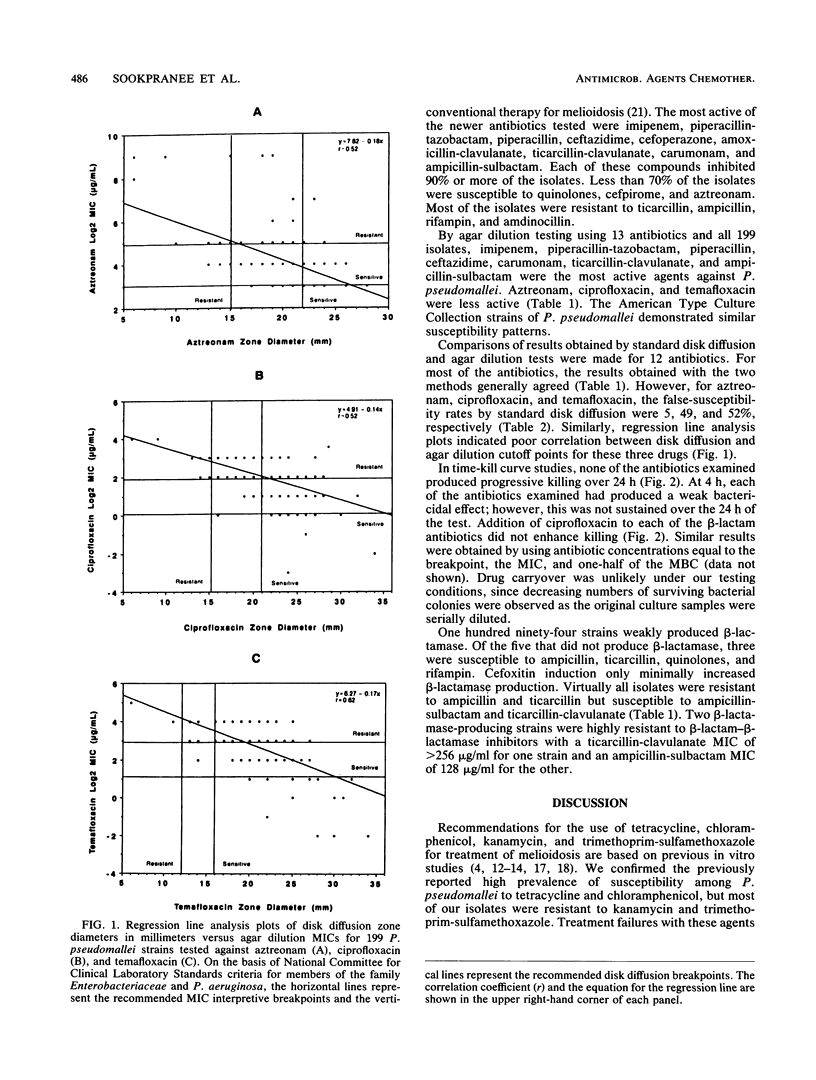
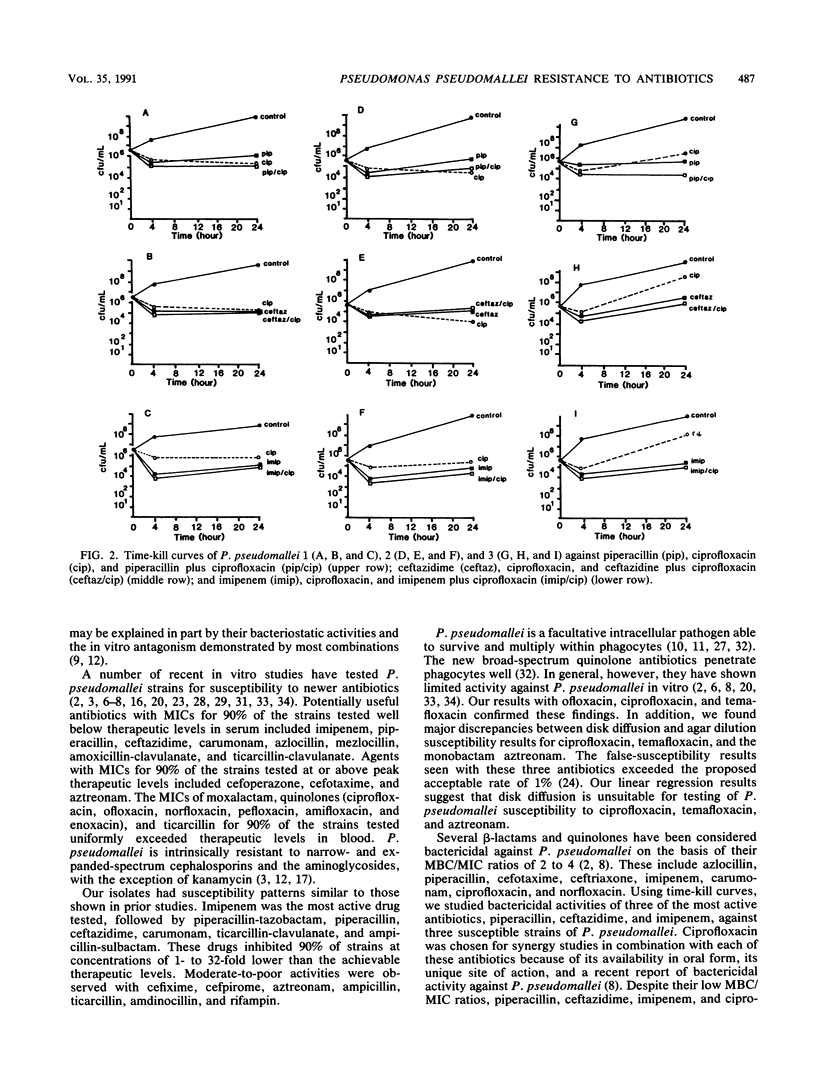
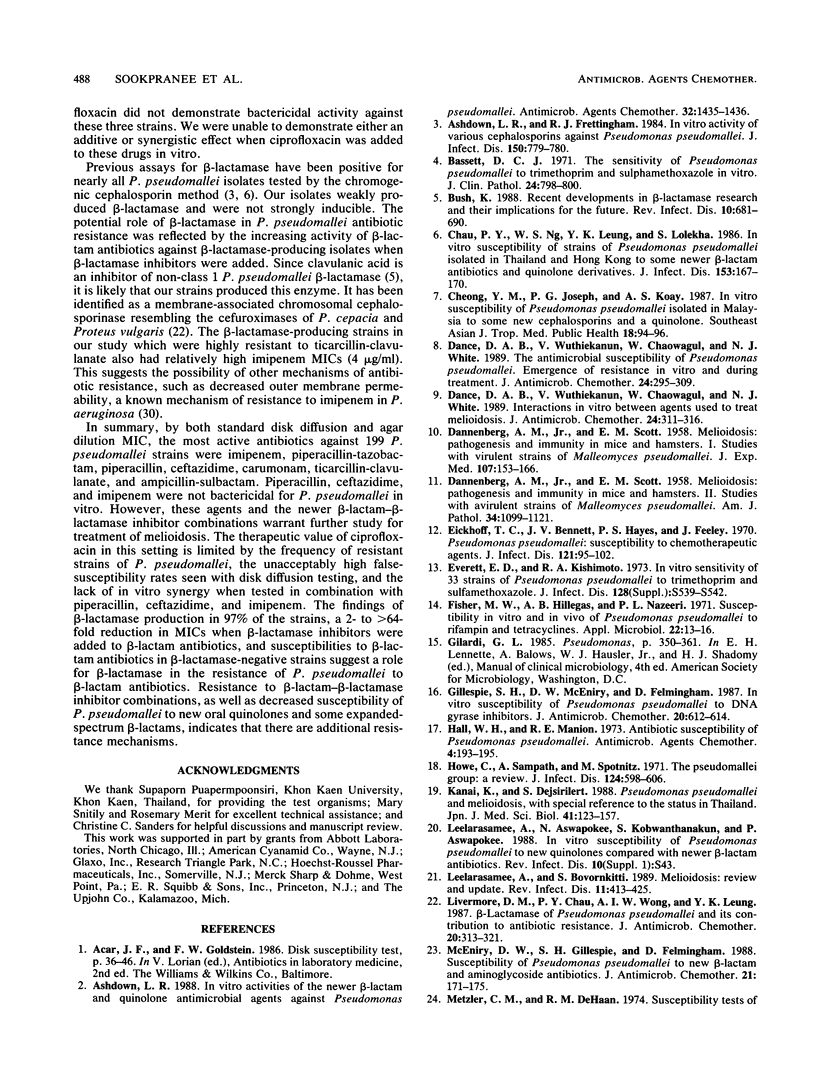
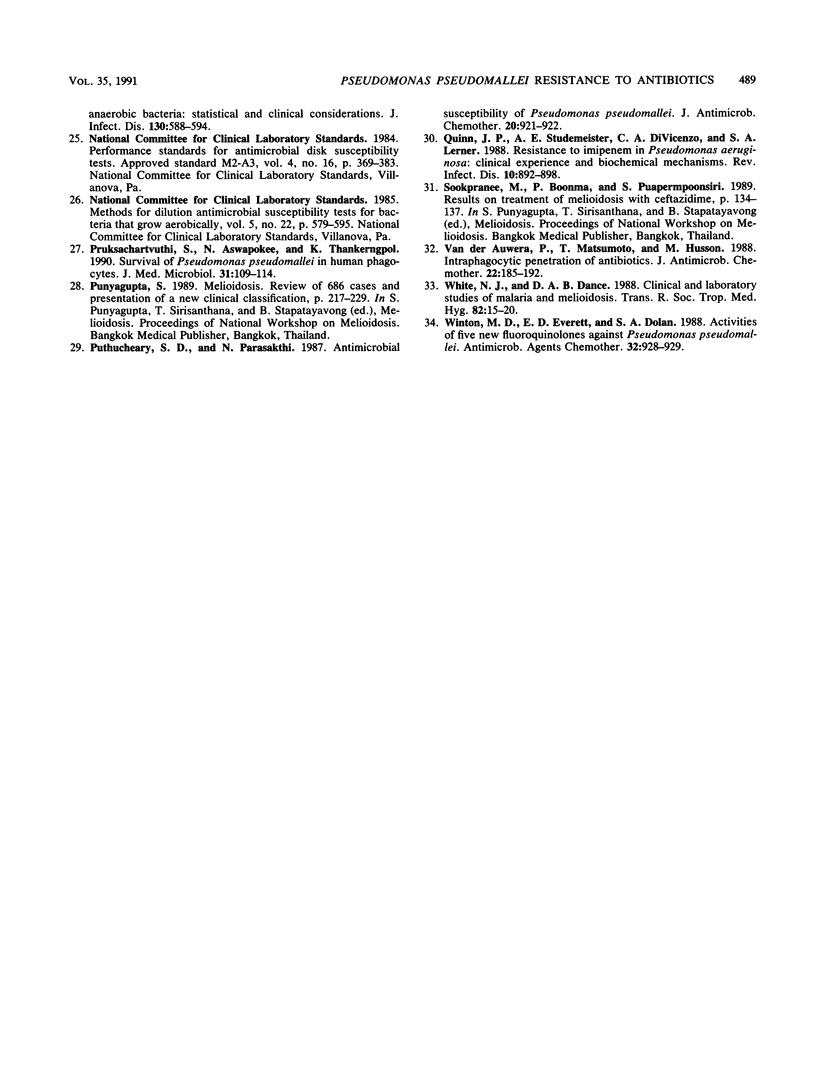
Selected References
These references are in PubMed. This may not be the complete list of references from this article.
- Ashdown L. R., Frettingham R. J. In vitro activity of various cephalosporins against Pseudomonas pseudomallei. J Infect Dis. 1984 Nov;150(5):779–780. doi: 10.1093/infdis/150.5.779. [DOI] [PubMed] [Google Scholar]
- Ashdown L. R. In vitro activities of the newer beta-lactam and quinolone antimicrobial agents against Pseudomonas pseudomallei. Antimicrob Agents Chemother. 1988 Sep;32(9):1435–1436. doi: 10.1128/aac.32.9.1435. [DOI] [PMC free article] [PubMed] [Google Scholar]
- Bassett D. C. The sensitivity of Pseudomonas pseudomallei to trimethoprim and sulphamethoxazole in vitro. J Clin Pathol. 1971 Dec;24(9):798–800. doi: 10.1136/jcp.24.9.798. [DOI] [PMC free article] [PubMed] [Google Scholar]
- Bush K. Recent developments in beta-lactamase research and their implications for the future. Rev Infect Dis. 1988 Jul-Aug;10(4):681–690. doi: 10.1093/clinids/10.4.681. [DOI] [PubMed] [Google Scholar]
- Chau P. Y., Ng W. S., Leung Y. K., Lolekha S. In vitro susceptibility of strains of Pseudomonas pseudomallei isolated in Thailand and Hong Kong to some newer beta-lactam antibiotics and quinolone derivatives. J Infect Dis. 1986 Jan;153(1):167–170. doi: 10.1093/infdis/153.1.167. [DOI] [PubMed] [Google Scholar]
- Cheong Y. M., Joseph P. G., Koay A. S. In-vitro susceptibility of Pseudomonas pseudomallei isolated in Malaysia to some new cephalosporins and a quinolone. Southeast Asian J Trop Med Public Health. 1987 Mar;18(1):94–96. [PubMed] [Google Scholar]
- DANNENBERG A. M., Jr, SCOTT E. M. Melioidosis: pathogenesis and immunity in mice and hamsters. I. Studies with virulent strains of Malleomyces pseudomallei. J Exp Med. 1958 Jan 1;107(1):153–166. doi: 10.1084/jem.107.1.153. [DOI] [PMC free article] [PubMed] [Google Scholar]
- DANNENBERG A. M., Jr, SCOTT E. M. Melioidosis: pathogenesis and immunity in mice and hamsters. II. Studies with avirulent strains of Malleomyces pseudomallei. Am J Pathol. 1958 Nov-Dec;34(6):1099–1121. [PMC free article] [PubMed] [Google Scholar]
- Dance D. A., Wuthiekanun V., Chaowagul W., White N. J. Interactions in vitro between agents used to treat melioidosis. J Antimicrob Chemother. 1989 Sep;24(3):311–316. doi: 10.1093/jac/24.3.311. [DOI] [PubMed] [Google Scholar]
- Dance D. A., Wuthiekanun V., Chaowagul W., White N. J. The antimicrobial susceptibility of Pseudomonas pseudomallei. Emergence of resistance in vitro and during treatment. J Antimicrob Chemother. 1989 Sep;24(3):295–309. doi: 10.1093/jac/24.3.295. [DOI] [PubMed] [Google Scholar]
- Eickhoff T. C., Bennett J. V., Hayes P. S., Feeley J. Pseudomonas pseudomallei: susceptibility to chemotherapeutic agents. J Infect Dis. 1970 Feb;121(2):95–102. doi: 10.1093/infdis/121.2.95. [DOI] [PubMed] [Google Scholar]
- Fisher M. W., Hillegas A. B., Nazeeri P. L. Susceptibility in vitro and in vivo of Pseudomonas pseudomallei to rifampin and tetracyclines. Appl Microbiol. 1971 Jul;22(1):13–16. doi: 10.1128/am.22.1.13-16.1971. [DOI] [PMC free article] [PubMed] [Google Scholar]
- Gillespie S. H., McEniry D. W., Felmingham D. In-vitro susceptibility of Pseudomonas pseudomallei to DNA gyrase inhibitors. J Antimicrob Chemother. 1987 Oct;20(4):612–614. doi: 10.1093/jac/20.4.612. [DOI] [PubMed] [Google Scholar]
- Hall W. H., Manion R. E. Antibiotic susceptibility of Pseudomonas pseudomallei. Antimicrob Agents Chemother. 1973 Aug;4(2):193–195. doi: 10.1128/aac.4.2.193. [DOI] [PMC free article] [PubMed] [Google Scholar]
- Howe C., Sampath A., Spotnitz M. The pseudomallei group: a review. J Infect Dis. 1971 Dec;124(6):598–606. doi: 10.1093/infdis/124.6.598. [DOI] [PubMed] [Google Scholar]
- Kanai K., Dejsirilert S. Pseudomonas pseudomallei and melioidosis, with special reference to the status in Thailand. Jpn J Med Sci Biol. 1988 Aug;41(4):123–157. doi: 10.7883/yoken1952.41.123. [DOI] [PubMed] [Google Scholar]
- Leelarasamee A., Bovornkitti S. Melioidosis: review and update. Rev Infect Dis. 1989 May-Jun;11(3):413–425. doi: 10.1093/clinids/11.3.413. [DOI] [PubMed] [Google Scholar]
- Livermore D. M., Chau P. Y., Wong A. I., Leung Y. K. beta-Lactamase of Pseudomonas pseudomallei and its contribution to antibiotic resistance. J Antimicrob Chemother. 1987 Sep;20(3):313–321. doi: 10.1093/jac/20.3.313. [DOI] [PubMed] [Google Scholar]
- McEniry D. W., Gillespie S. H., Felmingham D. Susceptibility of Pseudomonas pseudomallei to new beta-lactam and aminoglycoside antibiotics. J Antimicrob Chemother. 1988 Feb;21(2):171–175. doi: 10.1093/jac/21.2.171. [DOI] [PubMed] [Google Scholar]
- Metzler C. M., DeHaan R. M. Susceptibility tests of anaerobic bacteria: statistical and clinical considerations. J Infect Dis. 1974 Dec;130(6):588–594. doi: 10.1093/infdis/130.6.588. [DOI] [PubMed] [Google Scholar]
- Pruksachartvuthi S., Aswapokee N., Thankerngpol K. Survival of Pseudomonas pseudomallei in human phagocytes. J Med Microbiol. 1990 Feb;31(2):109–114. doi: 10.1099/00222615-31-2-109. [DOI] [PubMed] [Google Scholar]
- Puthucheary S. D., Parasakthi N. Antimicrobial susceptibility of Pseudomonas pseudomallei. J Antimicrob Chemother. 1987 Dec;20(6):921–922. doi: 10.1093/jac/20.6.921. [DOI] [PubMed] [Google Scholar]
- Quinn J. P., Studemeister A. E., DiVincenzo C. A., Lerner S. A. Resistance to imipenem in Pseudomonas aeruginosa: clinical experience and biochemical mechanisms. Rev Infect Dis. 1988 Jul-Aug;10(4):892–898. doi: 10.1093/clinids/10.4.892. [DOI] [PubMed] [Google Scholar]
- Van der Auwera P., Matsumoto T., Husson M. Intraphagocytic penetration of antibiotics. J Antimicrob Chemother. 1988 Aug;22(2):185–192. doi: 10.1093/jac/22.2.185. [DOI] [PubMed] [Google Scholar]
- White N. J., Dance D. A. Clinical and laboratory studies of malaria and melioidosis. Trans R Soc Trop Med Hyg. 1988;82(1):15–20. doi: 10.1016/0035-9203(88)90249-0. [DOI] [PubMed] [Google Scholar]
- Winton M. D., Everett E. D., Dolan S. A. Activities of five new fluoroquinolones against Pseudomonas pseudomallei. Antimicrob Agents Chemother. 1988 Jun;32(6):928–929. doi: 10.1128/aac.32.6.928. [DOI] [PMC free article] [PubMed] [Google Scholar]


